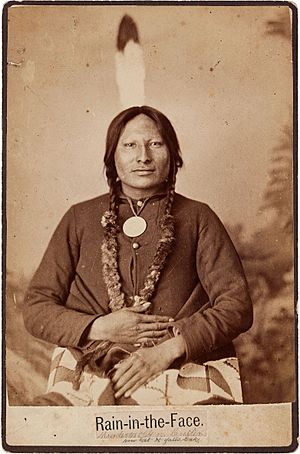Rain-in-the-Face facts for kids
Quick facts for kids
Rain-in-the-Face
|
|
|---|---|
| Ité Omáǧažu | |

Rain-in-the-Face in 1874
|
|
| Lakota leader | |
| Personal details | |
| Born | c. 1835 |
| Died | September 15, 1905 (aged 69–70) Bullhead Station, Standing Rock Reservation (North and South Dakota) |
| Signature | |
Rain-in-the-Face (in the Lakota tongue: Ité Omáǧažu) was a brave and important leader of the Lakota tribe. He was born around 1835 and passed away on September 15, 1905. He is well-known for his part in the Battle of the Little Bighorn in 1876. In this famous battle, the Lakota and their allies defeated the U.S. 7th Cavalry led by Lt. Colonel George Armstrong Custer.
Contents
Rain-in-the-Face's Early Life
Rain-in-the-Face was born near the Cheyenne River in what is now Dakota Territory. He was part of the Hunkpapa band of the Lakota nation.
How He Got His Name
His name, "Rain-in-the-Face," has a cool story behind it.
- One idea is that when he was a boy, he got into a fight. His face was splattered with blood, making it look like rain.
- Another story he told later in life was about a battle. He fought in a heavy rainstorm against the Gros Ventre tribe. After the long fight, his war paint was streaked across his face, like rain.
Fighting for His People
Rain-in-the-Face was a warrior who fought to protect his people and their lands.
Early Battles
- In 1866, he took part in a raid against Fort Totten.
- In 1868, he fought the U.S. Army again. This happened near Fort Phil Kearny in Wyoming.
- In 1873, he was involved in another fight. This was called the Battle of Honsinger Bluff.
Arrest and Escape
Later, Rain-in-the-Face returned to the Standing Rock Indian Reservation. In 1874, he was arrested by Captain Thomas Custer. This was because he was believed to be involved in the death of an army veterinarian named Dr. John Honsinger. He was taken to Fort Abraham Lincoln and put in prison. However, he managed to escape and went to the Powder River area.
The Battle of Little Bighorn
In the spring of 1876, Rain-in-the-Face joined Sitting Bull's group. They traveled to the Little Bighorn River in June.
A Famous Legend
During the Battle of the Little Bighorn on June 25, 1876, a famous story began. It was said that Rain-in-the-Face took revenge on Thomas Custer. This legend became very popular, even appearing in a poem by Henry Wadsworth Longfellow. Some stories also claimed he fought against George Custer himself. However, many warriors were involved in the confusing battle, so it's hard to know exactly what happened.
Later Years and Legacy
After the Battle of Little Bighorn, Rain-in-the-Face and other Hunkpapa people went north. They lived in Canada for several years.
Returning to the Reservation
In 1880, Rain-in-the-Face led his group to surrender. The next year, they moved to the Standing Rock Indian Reservation. In 1881, a count showed that his group had 39 families, or 180 people.
His Final Days
Rain-in-the-Face passed away in his home in Bullhead Station. This was on the Standing Rock Reservation. He had been sick for a long time. It is said that before he died, he told a missionary something interesting. He thought he might have been the one who shot Custer. He said he was so close that it left powder marks on Custer's face.
See also
 In Spanish: Lluvia en la cara para niños
In Spanish: Lluvia en la cara para niños


